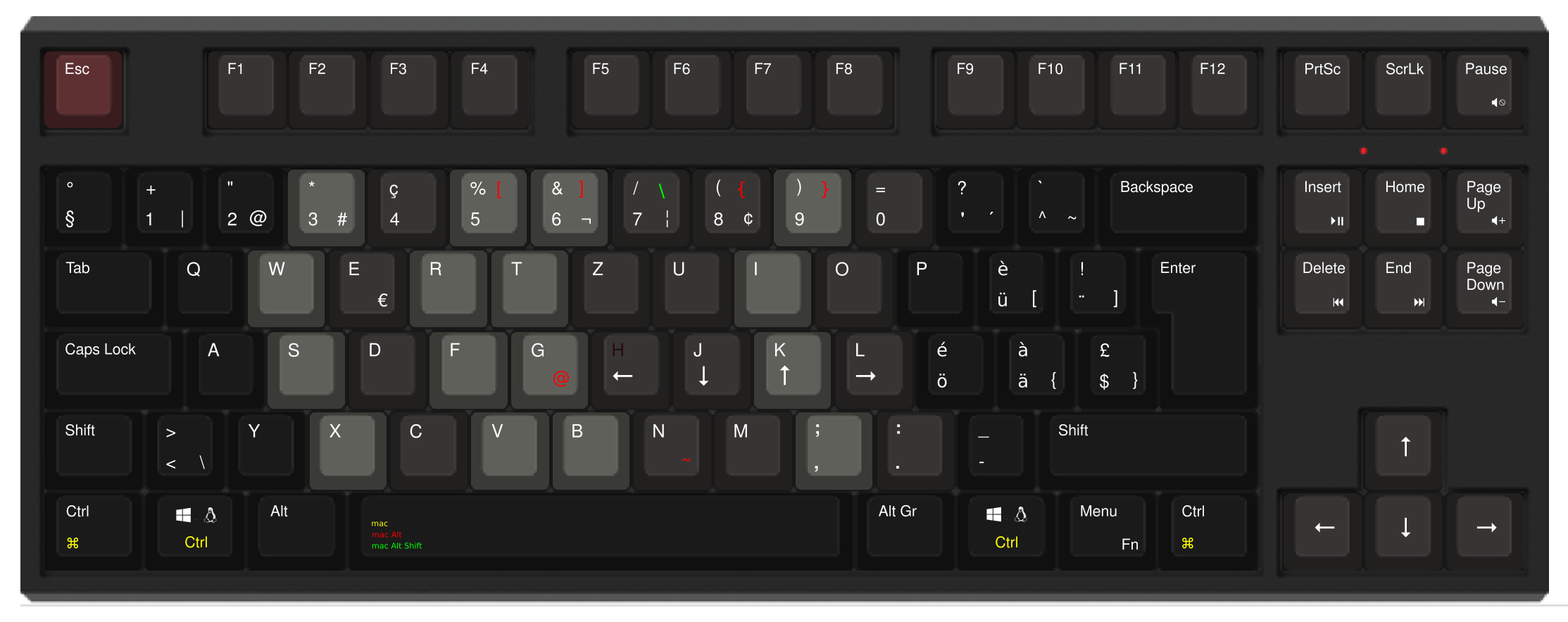Swiss Developer Keyboard

This is the Swiss Developer Keyboard, a keyboard specifically designed for developers working in Switzerland. None of the large manufacturers had a good quality mechanical keyboard with a Swiss Layout, so I created a custom design, which you can now also buy!
I'm assuming that you work with different OSes (MacOS/Windows/Linux).
Features I added
Swiss Layout
As most European languages have some extra characters in their alphabet, the keys which, in US keyboards, are used for the keys that programmers need - brackets, slashes, etc. are taken over by the extra characters. Typically, the 'programmer keys' are then relegated to obscure parts of the keyboard, attainable through combinations of modifier keys (shift and Alt) and normal keys.
It's quite painful to program on a Swiss keyboard, and for a while I changed my layout to US American and Programmer's Dvorak.
It worked fine, as long as I was on my computer in my office, but it went spectacularly wrong the first time I visited a customer. I was unable to type on their keyboards. My muscle memory was writing Dvorak. This is particularly painful if you're trying to enter a password which is not displayed on screen.
So my unmitigated recommendation is to keep with the layout of your country, because that enables you to use any keyboard found at a customer.
Mac OS mapping of 'Developer characters' on the keyboard
Apple places its special characters at different places than the standard PC Keyboard. Normal people don't notice this, but developers need on a constant basis 'special' characters - for instance, \ or { or ~ and these are not engraved on the Apple Keyboards. I used to have a small bit of paper with the positions of these characters.
Keycap shading for correct 10-finger positioning
Developers type all the time. Learning to touch type is one of the most useful basic skills, but there are always a couple of keys which confused me - B and 6, for instance. Are they right-hand keys or left-hand keys. The solution is the keycap shading, which indicates which finger you should be using.
Additional arrows on hjkl for easier vi editing
vi is a very old, very fast text editor which is universally present on all unix/linux servers. One navigates through to different parts of the text with the normal keys, and hjkl are the keys used for basic, one-step movement. I always forget which is which, so I've added some arrows on those keys.
Good ergonomics - no number pad
It's important to avoid wrist injury to keep the mouse as close to the keyboard as possible. That's why the number block is evil, and you should be touch-typing your numbers in any case.
Features that are provided by the manufacturer, WASD
This keyboard is manufactured by WASD, an American producer of high-quality custom-made keyboards. The underlying hardware is the V2 Keyboard which comes with the following super features:
- Very robust - it's a heavy keyboard
- Beautiful Cherry MX Switches. I recommend the clear switches if you need something quiet, and the blue switches if you like a loud click (not good for open-floor offices)
- DIP Switches that allow you to modify the keyboard at the hardware level. My favorites:
- Switch Caps Lock to Ctrl. Gives your pinky a lot of relief!
- Built-in Function commands. If you look at the Navigation block (Page Up, Page Down, etc) you'll see that there is an overlay for play/pause, volume, etc. These keys, when pressed with the Fn key, send actual hardware codes for media control.
Price and Ordering
The price of the keyboard comes to about 200 USD (including shipping to Switzerland). It's not cheap, but this is a beautiful piece of hardware that should survive a number of productive years.
You can order the keyboard from wasd here.